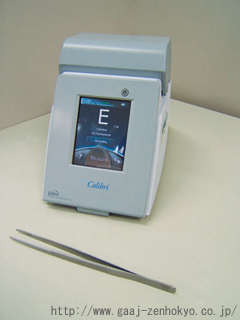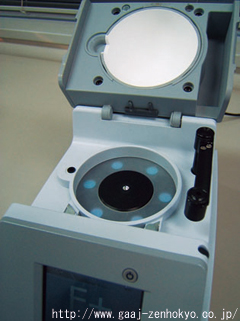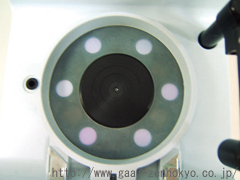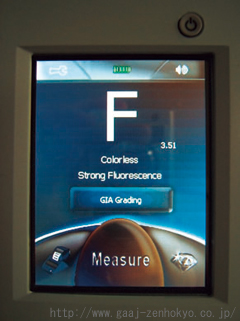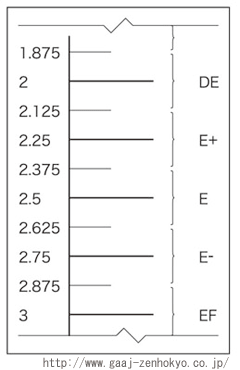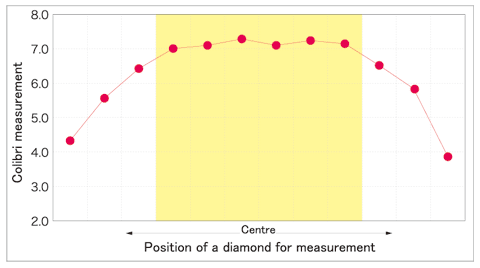|
||||||||||||
“Colibri™?Ewas developed by Sarin Technologies Ltd. as an automatic colour-grading instrument for cape series diamonds. GAAJ-ZENHOKYO Laboratory examined the characteristics and practicality of the Colibri™ by measuring about 14,000 diamonds on the instrument while in the process of general routine work. The results confirmed that this instrument could be fairly useful as reference for objective colour grading on the majority of cape series diamonds providing the instrument is properly used. The details are reported here. |
||||||||||||
|
◆Introduction The widely adopted colour grading system that applies the D-to-Z scale is the one created by GIA. An experienced grader performs the colour grading, comparing the tested stone to a set of master stones. For consistent results grading should be done in specific conditions, as reported in detail in the latest Gems & Gemmology (Gems & Gemmology, 2008 winter). In Japan, JJA/AGL introduced authorized Master Stone Sets in 1996, which all AGL members have been using for diamond colour grading. Meanwhile, as a means of obtaining objective grading results, world-leading laboratories such as GIA have been examining the possibility of an automatic colour-grading instrument. A common instrument to measure colour is called a colorimeter, which can measure all colour ranges. However, this colorimeter does not give consistent results on transparent materials such as diamonds. The instruments our laboratory uses when necessary for colour grading are Kalnew Gemcolor II and Hamamatsu Photonics Multi-colour analyser C-5940, however, these instruments are not suitable for routine work regarding consistency and efficiency. Sarin Technologies Ltd., which has been producing and distributing various measuring instruments for diamonds such as DiaMension™ for cut grading, has also been focusing on colour grading instruments for diamonds and recently released a new automatic colour-grading instrument “Colibri™?Ein 2006. ZENHOKYO Israel examined the practicality of this instrument soon after its release, and provided Sarin with the results of these examinations. As a result, the model was upgraded several times in order to improve its efficiency. Our laboratory examined the 2008 model of the instrument and conducted a more detailed analysis. The Colibri™ specialises in colour grading of faceted type Ia diamonds in cape series colour, and according to Sarin Technologies, the introduction of this new measurement system has enhanced the precision and consistency of colour grading. Almost 90% of diamonds colour-graded at GAAJ-ZENHOKYO Laboratory are from the cape colour range; therefore, understanding Colibri™’s characteristics will ensure the possibility of using the instrument as reference for general colour grading work. GAAJ-ZENHOKYO tested about 14,000 diamonds that were randomly selected from those colour-graded in our routine work. In order to examine the characteristics and effectiveness of the instrument, the diamonds were measured by three Colibri™ units that were tuned by Sarin. In the present study, the diamonds tested were limited only to round brilliant-cut stones. In a preliminary measurement, some diamonds in shapes other than round brilliant have shown tendency different from round brilliant-cut diamonds due to the different light path. However, the amount of samples tested was not enough to specify the tendency and more measurements will be required to understand more accurate trend of diamonds in shapes other than round brilliant.
|
||||||||||||
|
◆Outline of Colibri™ ??The exterior of Colibri? is shown in Figure 1. This instrument is suitable for laboratory use, as well as a sales tool at retail shops. It requires only a small space, weighs only 1.2kg and is portable. It works with a household electric power supply of 100V or a rechargeable battery with 10 hours of continuous operation. Touch panel operation of the instrument is user-friendly. ??Sample to be tested can be either loose or mounted ranging from 0.2 and 270 carats (according to Sarin Technologies). The sample chamber is under the top lid, in which the diamond is placed face down in the centre of a small circle window for measurement (Figure 2). At measurement, light beams from six surrounding luminescence windows that are reflected diffusely at a dome placed at the back of the top lid, focused on the diamond, so the instrument receives the light beams passed through the pavilion to the table. While colour is graded, the intensity of UV fluorescence can also be measured by illuminating visible light and UV light alternately. ??Colour grading with this instrument does not require master stones. The diamond is graded by comparing the measurement result of the stone with a measurement result of the empty chamber. The result is shown in a numeric value between 1.50 and about 12.50 (at 0.01 intervals to second decimal places) with a corresponding grade that is pre-set in the machine for the different grading systems such as GIA, AGS or HRD. When GIA’s grading system with D-to-Z scale is selected, stones graded between 1.5 and 2.0 generally correspond to D colour, likewise, those between 2.0 to 3.0, or 3.0 to 4.0, correspond to E or F colour respectively. Accordingly, as the measured value increases by 1.0, the corresponding colour grade lowers from G onwards. Thus, as Colibri? measurement indicates smaller numeric values the diamond has a better colour grade. A measured value close to the minimum end of the range in which the value falls is shown with a ?E?Emark after the assigned alphabetical colour grade, and in the same manner, a value close to the maximum end is shown with ?E?Emark. As for a value around the border, it is shown with both alphabetical grades. For example, a result between 1.88 and 2.12 is shown as “DE?E likewise, 2.13-2.37 as “E+?E 2.38-2.62 as “E?E 2.63-2.87 as “E-?Eand 2.87-3.12 as “EF?E(Figure 3). ??The measurement can be performed in less than five seconds or about fifteen seconds if including setting the stone in the machine, thus this test is suitable for routine work in a laboratory.
|
||||||||||||
| ◆Consistency of measurements The following steps were taken in order to confirm consistency of measurements: 1. The stone was measured several times while the stone remained set in the instrument: The results showed almost the same values with minute differences. 2. The stone was measured several times at different hours of the day (morning, noon and evening), with re-setting the stone each time: 12 sample diamonds from D to J colour were each measured six times. The results differed in the ±0.4 range from the average value (Figure 4) and this tendency was commonly seen in each colour grade. Sarin states that error on Colibri? falls within ±1/2 grade, and our results are almost equivalent to this. 3. Measured by different Colibri? units: The 12 stones measured in test?2. were also measured by three different units. The results did not vary much, and the error on the Colibri? can be negligible. 4. Measured in different positions on the measuring window: The results of stones measured in positions slightly moved away from the centre are almost the same, however, when the stone is moved from the centre beyond a certain range the result values were reduced significantly (Figure 5). It is understood that consistent measurement results can be obtained as long as the table facet covers the whole measuring window, otherwise, the result values obtained become smaller than the true values. Small stones should therefore be set carefully in the instrument so that the table facet covers the whole measuring window.
|
||||||||||||
|
||||||||||||
